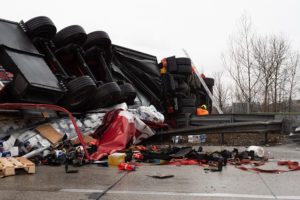One of the most severe types of accidents on roadways throughout the U.S. involves commercial trucks. These trucks are massive in size and pose maneuverability issues that make them harder to operate than other vehicles and more prone to certain types of accidents, including rollovers.
Here is a look at truck rollovers, what causes them, and how to seek compensation with truck accident lawyer if a truck rollover injured you or took a loved one.
Why Are Trucks More Likely Roll Over Than Other Vehicles?
Large commercial trucks, commonly referred to as semi-trucks or tractor-trailers, have a standard length of 48-53 feet, a width of 8.5 feet, and height of 13.5 feet. With a tall, narrow profile, they feature a higher center of gravity than other vehicle types, making them more likely to roll over in certain situations.
The Federal Motor Carrier Safety Administration (FMCSA) is the federal agency tasked with overseeing and regulating the U.S. trucking industry. Their study showed that rollover crashes involving large trucks generally result from their high center of gravity. Rollovers can happen when the truck driver attempts to take a corner or curve too fast with an imbalanced load.
Some of the driver behaviors that can lead to a truck rollover include:
Excess Speed
The FMCSA study revealed that most truck rollovers occur on curved stretches of the road such as freeway entrances and exits where the driver is driving at higher speeds without considering the impact of the vehicle’s high center of gravity.
As noted by Commercial Fleet Data Systems, the posted speed limits on the freeway on and off ramps are intended for passenger vehicles, not commercial trucks. Truck drivers are encouraged to travel these roadways at five to 10 miles below the posted speed limit to reduce the centrifugal force on the vehicle, which causes the vehicle to lean away from the direction of the curve.
According to the FMCSA study, excess speed is the leading factor in truck rollover crashes, accounting for nearly half of all rollovers involving commercial trucks. Most truck rollovers attributed to extra speed have the driver misjudging the speed at which they can safely travel a curved road.
Imbalanced Cargo
Another contributor to rollovers is how the cargo is loaded into the commercial truck’s trailer. Whether the truck driver loaded the truck or the shipper did, many truck rollovers result from loads heavier than the driver is legally permitted to carry. In other cases, they are improperly fastened and subject to shifting when the driver is taking a corner, curve, or changing lanes. Some cargo are mounted too high in the truck, rendering the vehicle top-heavy. Imbalanced cargo commonly combines with excess speed to result in an accident.
The Vehicle’s Brakes
When fully loaded, a tractor-trailer can weigh up to 80,000 pounds and be legally operated on most types of roadways. The heavy loads transported in commercial trucks and the significant miles these trucks operate with cumbersome loads cause certain vehicle parts to wear out more quickly, including the tires and the brakes. Several rollover truck accidents are caused due to the vehicle’s brakes being insufficient to slow the weight of the vehicle before it enters the curve.
Trucking owners/operators and trucking companies must provide regular maintenance on the trucks used in their business to avoid accidents caused by the wearing of certain parts.
Truck drivers are required to perform a pre-trip inspection of the vehicle before every trip to look for visibly worn parts that can prevent the vehicle from being safely operated. Many of the truck rollovers analyzed in the FMCSA study involved poorly maintained brakes and occurred far enough into the journey that the driver should have been aware of the issue.
The Vehicle’s Tires
Tires are also commonly subject to excessive wear on commercial trucks. In some truck accidents appearing in the FMCSA’s report, the driver was unable to sufficiently slow down when entering a curve due to worn tires not having the grip on the roadway needed to perform the maneuver.
The tires can also make it more difficult to control the truck as it travels downhill. In addition to shifting cargo, rollovers can result in a driver losing control of their vehicle and striking a median or other object that “trips” the vehicle’s tires.
Driver Inattention
Truck rollovers can happen when a truck driver attempts to perform emergency driving maneuvers to prevent an accident, such as avoiding a rear-end collision when another driver slows or stops by swerving. The swerve can result in a cargo imbalance or an extreme shift of the truck’s weight, causing a rollover.
Driver fatigue is one of the leading types of inattention resulting in this type of accident. According to the FMCSA, 13 percent of the truck drivers in accidents report that they were tired at the time of the crash. Truck drivers often are required to work long hours and commonly drive during the late night hours to avoid traffic that will slow them down while they are on a tight schedule. Further, many long-haul truck drivers save time and money by sleeping in their truck’s sleeper berth.
The human body is instinctively wired to be awake during hours of light and asleep in hours of darkness. Because of this instinct, many late-night truck drivers find themselves extremely tired while working. Many others suffer from medical conditions such as sleep apnea that cause them to feel unrested, even when they have gotten enough sleep. However, sleep inertia is one of the most common causes of truck accidents resulting from driver fatigue.
FMCSA explains that sleep inertia refers to the impairment of the driver’s skills and abilities to drive the vehicle safely within an hour or so of waking up, such as short-term memory, vigilance, and reaction time. When drivers sleep in the sleeper berth, they deprive themselves of the time they need to fully wake up and gain the alertness required to avoid an accident.
Driver distractions are another common cause of inattention that leads to truck rollovers. Truck drivers can spend hours alone in their vehicles and often pass the time by eating, drinking, smoking, adjusting stereo and vehicle controls, communicating with their dispatcher, texting and other cell phone use, or daydreaming. All these distractions reduce the driver’s ability to operate the vehicle safely.
Overcorrecting
To avoid causing an accident, truck drivers must not only maintain control of their vehicle by traveling at a safe speed and paying attention to the actions of other drivers but also avoid overcorrecting when it comes time to respond to a hazard.
Overcorrecting is the most common steering-related issue that results in truck rollovers, with drivers failing to realize that suddenly changing the direction of the truck impacts its stability.
Lack of Visual Search
A considerable 13 percent of all truck crashes involve the failure of the driver to adequately look for hazards, such as failing to ensure that no vehicles are approaching at a stop sign or checking the truck’s blind spot before changing lanes.
Commercial trucks do not have a rear-view mirror and significant blind spots on all four sides that require the driver to manually twist and look over their shoulder to see other vehicles traveling alongside them. This is no surprise to truck drivers, however, as part of the basics of operating the truck is learning how to deal with its blind spots.
Seeking Compensation if a Truck Rollover Injured You

Having a vehicle that can be up to 53 feet long rollover in the roadway often results in a significant risk of injury or death to the occupants of other vehicles on the road. They can become trapped beneath the rolled truck, struck by it, or even result in chain reaction crashes in which other vehicles crash into the one that has rolled.
As noted, there are many negligent driving behaviors that a truck driver can exhibit that can result in a crash. Truck drivers have a higher duty of care when it comes to protecting others on the roadway due to the size and commerciality of the vehicle. Truck drivers and trucking companies must take additional actions to protect others beyond the duty owed by all drivers to operate their vehicles safely and legally.
Some of those requirements include:
- Obtaining a special license to drive the vehicle, known as a commercial driver’s license (CDL). This license requires the driver to pass a test to show they know the basics of operating the truck and performing the pre-trip inspection. This also subjects the driver to routine physical examinations and drug and alcohol screenings to ensure they are fit for the job.
- Electronically logging their hours to show that they’ve taken the required off-duty breaks needed to be well rested and refreshed when driving.
- Performing routine maintenance and pre-trip inspections to ensure that the truck does not have defects that would compromise its safety.
- Companies must screen drivers to ensure that they maintain a clean driving record.
How the Truck Accident Claims Process Works?
Were you injured as a result of a truck rollover? You can seek compensation for the expenses and impacts of your injury through a personal injury claim filed against the liability insurance policy held by the trucking company or the owner/operator of the truck.
When the claim is received, the insurance provider will analyze the details of the case, interview the parties involved and any witnesses, and study the documentation showing expenses related to the treatment of injuries resulting from the accident. They will then decide to accept, deny, or settle the claim. Initial settlement offers made after a truck rollover has caused injuries to others are often far below the claim’s value. The claimant’s attorney will negotiate with the insurer to get them to increase that offer.
Suppose the at-fault company or trucker’s insurance provider fails to compensate the claim. In that case, it can be filed as a personal injury lawsuit within the statute of limitations for personal injury claims in the state where the accident occurred. Most states have personal injury statutes of limitations ranging from one to four years.
The Importance of Hiring an Attorney After a Truck Accident
Many federal regulations are placed on the trucking industry to protect the safety of other roadway users. But to prove liability for a truck accident and the high-powered insurers and lawyers who work with the trucking industry, you need to produce certain evidence for your claim. Hiring an experienced truck accident lawyer can be integral to obtaining the compensation you need.
A truck accident attorney brings experience to the claim, helping the claimant to understand the process. The attorney ensures that the claimant has a right to seek compensation by filing their claim within the statute of limitations and that the claim’s value is protected from the tactics that trucking industry insurers often use to decrease or eliminate claim values.
Hiring an truck accident attorney is affordable for anyone who needs their services. This type of lawyer typically uses a contingent fee billing method that allows the claimant to wait until their claim has been compensated before paying for the services of their lawyer.
If a truck accident injured you, contact an experienced truck accident attorney explore your legal options with you and answer your questions about your case.

